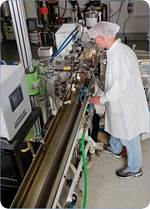Extrusion Process Eliminates Assembly of Medical Catheter Shafts
Putnam Plastics Corp., Dayville, Conn. (putnamplastics.com), has developed new extrusion technology that replaces manually assembled medical guide catheter shafts with a single, three-layer component.
Putnam Plastics Corp., Dayville, Conn. (putnamplastics.com), has developed new extrusion technology that replaces manually assembled medical guide catheter shafts with a single, three-layer component. Called Tri-Tie, the proprietary process creates a three-layer composite shaft with maximum adhesion between the layers for improved performance without manual assembly.
Guide catheters are typically used to access endovascular sites and deliver balloons, stents, guide wires, contrast media, and other devices. These catheters are costly and challenging to manufacture due to complex shaft requirements, which include a lubricious inner layer, a braided stainless-steel middle layer, and a variable-durometer outer layer. Product performance can vary due to poor bonding between the layers and at the union of the outer layer segments, where hinge points occur. Putnam’s new process provides more gradual transitions in the outer layer without bonding or hinge points.
Says Ray Rilling, Putnam’s R&D director, “While the technologies and materials used for this process have a track record in vascular catheter applications, the combination in a single component is a hallmark of Putnam’s innovative approach.”
Related Content
-
How to Select the Right Tooling for Pipe Extrusion
In pipe extrusion, selecting or building a complementary set of tooling often poses challenges due to a range of qualitative factors. Here’s some guidance to help you out.
-
The Importance of Barrel Heat and Melt Temperature
Barrel temperature may impact melting in the case of very small extruders running very slowly. Otherwise, melting is mainly the result of shear heating of the polymer.
-
Understanding Melting in Single-Screw Extruders
You can better visualize the melting process by “flipping” the observation point so the barrel appears to be turning clockwise around a stationary screw.



